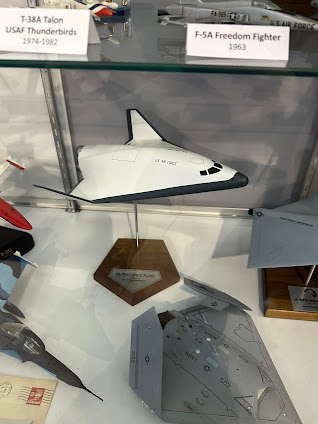 |
| A desktop model of the Northrop Grumman Military Space Plane at the Western Museum of Flight, photographed by me on December 16, 2023. |
In the mid-1990s, Northrop Grumman began design studies for a single-stage-to-orbit (SSTO) military spaceplane designed to go to low Earth orbit by means of in-flight refueling under the descriptive label Transatmospheric Vehicle (TAV). This project was influenced by the Black Horse concept for an SSTO spaceplane capable of refueling from tanker aircraft en route to orbit that was conceived in 1993 by US Air Force Captain Mitchell Burnside Clapp, who knew very well the USAF's use of aerial refueling to extend the performance of combat aircraft. As with the Black Horse concept the Northrop Grumman spaceplane was intended to take off from a runway with rocket power but with nearly empty liquid oxygen tanks and refuel from another spaceplane, after which it would utilize a suborbital boost and then launch an upper stage from the inner bay in order to reach orbit. To signal to the US Air Force its desire for greater involvement in military space programs, Northrop Grumman rebranded the TAV by the moniker Military Space Plane in the late 1990s. Three different designs of the Northrop Grumman Military Space Plane were done for various propellant combinations, including one utilizing a jet fuel/hydrogen peroxide fuel combination and a bulbous vehicle fueled by liquid hydrogen and liquid oxygen. The design of the Military Space Plane featured a blunt nose section, voluminous space in the center section for the fuel tanks and two outwardly canted vertical fins at the edges of the wings.
In 2000, NASA and the Defense Department jointly established the Space Launch Initiative (SLI) to determine the requirements to meet all of the hypersonics, space launch and space technology needs on part of the US in the civil and military fields, awarding reusable launch vehicle study contracts to the various aerospace companies involved in RLV design. The Northrop Grumman Military Space Plane ended up languishing at the design phase due to a lack of customer interest from the USAF, Northrop incorporated aspects of the design, including the outwardly canted vertical fins and blunt nose, into a manned spaceplane proposal which it jointly conceived with Orbital Sciences in 2002 for the Orbital Space Plane (OSP) program, which was now one of of the two components of the Second Generation Reusable Launch Vehicle program that evolved from the SLI (the other being the Next Generation Launch Technology (NGLT) program) after the X-33 and X-34 programs were cancelled in March 2001. It didn't matter in the end, however, because the OSP program was axed in 2004 after President George W. Bush announced the Vision for Space Exploration.
References:
Chong, T., 2016. Flying Wings & Radical Things: Northrop's Secret Aerospace Projects & Concepts 1939-1994. Forest Lake, MN: Specialty Press.




No comments:
Post a Comment